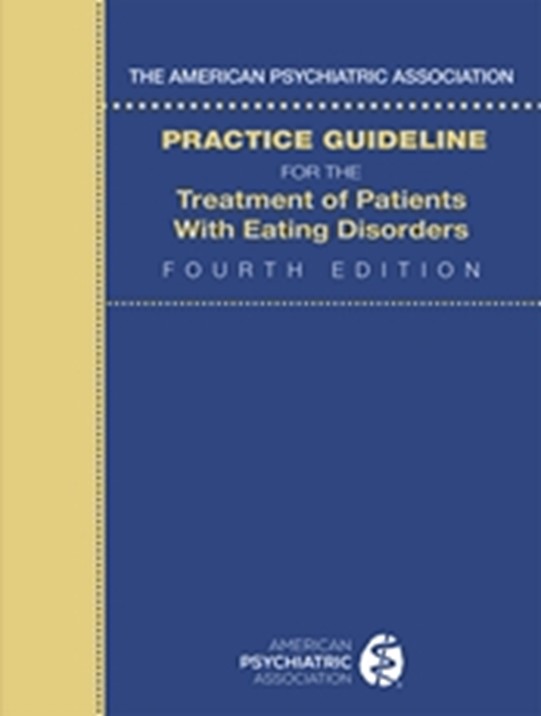Washington, D.C., — The American Psychiatric Association (APA) recently published an updated practice guideline for treatment of patients with eating disorders. The guideline provides recommendations on assessment and evidence-based pharmacological, psychotherapeutic, and other nonpharmacological treatments for eating disorders. The Practice Guideline for the Treatment of Patients with Eating Disorders focuses primarily on anorexia nervosa, bulimia nervosa, and binge-eating disorder and includes new tips for screening and treatment.

The lifetime prevalence of eating disorders in the U.S. is approximately 0.80% for anorexia nervosa, 0.28% for bulimia nervosa, and 0.85% for binge-eating disorder, although estimates can vary. Eating disorders often begin in adolescence or early adulthood and can persist for decades with significant psychosocial impairments.
The practice guideline includes 16 clinical recommendations or suggestions, depending on the level of scientific evidence, including:
Screening for the presence of an eating disorder as part of an initial psychiatric evaluation.
Conducting comprehensive patient evaluations, including laboratory tests and electrocardiograms.
Ensuring the treatment plan is patient-centered and culturally sensitive.
Setting individualized weight goals for patients with anorexia.
Treating patients with anorexia, bulimia, and binge-eating disorders with eating-disorder–focused psychotherapy.
Incorporating family-based therapy as part of a treatment plan for adolescents with anorexia or bulimia.
Discussion of assessment and treatment of avoidant/restrictive food intake disorder (ARFID) is included; however, recommendations are not included due to limited availability of clinical research data.
“Eating disorders often are unrecognized and untreated,” noted Catherine Crone, M.D., chair of the guideline writing group. “This guideline and supplementary resources are intended to serve as a practical tool for clinicians, to help with screening, diagnosis, and providing evidence-based treatment for eating disorders.”
The release of this new practice guideline comes at an important juncture for people with eating disorders. Studies have reported upticks in individuals developing symptoms of and requiring hospitalization for disordered eating since the start of the COVID-19 pandemic in 2020. See more information in Psychiatric News: “Special Report: Youth With Eating Disorders—Time Is of the Essence in Achieving Remission.”
Eating Disorder Guideline Resources
The guideline provides direction on implementing the 16 clinical recommendations into practice. To facilitate understanding and its implementation, APA has developed a series of resources and tools, as outlined below. All are freely available to practitioners and the public.
Executive Summary of the Eating Disorders Practice Guideline (published in the American Journal of Psychiatry)
Pocket Guide for Clinicians – includes the guideline recommendations, lists of screening and assessment tools, and description of treatment options. Available in online (e-flipbook – free) and printed copy (for purchase).
CME Learning Activity – an online interactive educational program. Available through the APA Learning Center.
Training Slides – provide a summary of the practice guidelines that can be used as a training tool. (PowerPoint presentation)
Additional materials that will be available in the next few weeks include: an Interactive Toolkit (with screening assessment calculator, quantitative assessments, and diagnostic criteria and management recommendations) and a Pocket Guide for Patients and Families.
The guideline was developed by the APA Practice Guideline Writing Group chaired by Catherine Crone, M.D., using a process intended to be consistent with the recommendations of the Institute of Medicine and the Council of Medical Specialty Societies. Parameters used for the guideline’s systematic review are included with the full text of the guideline. (A detailed description of the process is included in the guideline.)
The development of the online toolkit and other supporting resources was made possible through a grant from the Council of Medical Specialty Societies. The full Practice Guideline for the Treatment of Patients with Eating Disorder Guideline is available from APA Publishing: free online and printed copy for purchase.
American Psychiatric Association
The American Psychiatric Association, founded in 1844, is the oldest medical association in the country. The APA is also the largest psychiatric association in the world with more than 38,000 physician members specializing in the diagnosis, treatment, prevention, and research of mental illnesses. APA’s vision is to ensure access to quality psychiatric diagnosis and treatment. For more information, please visit www.psychiatry.org.

